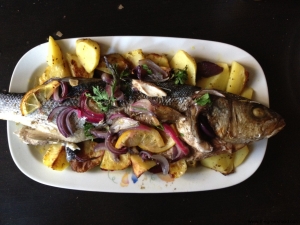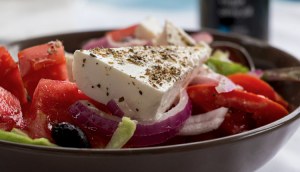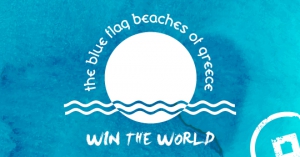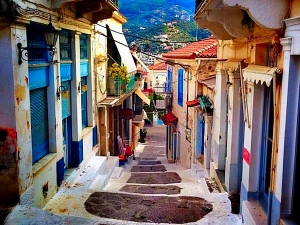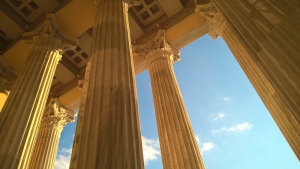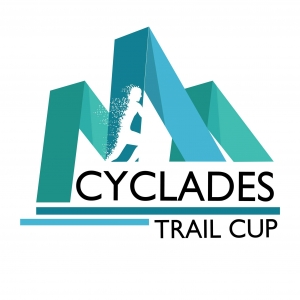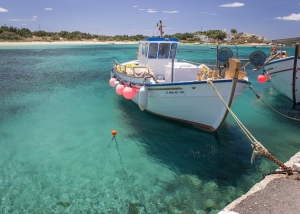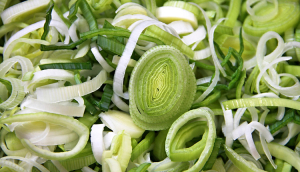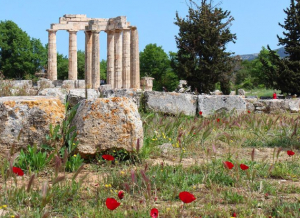XpatAthens
Sea Bass With Lemon And Potatoes
In Greece, summer is always combined with good fish. The last time I was in the local market I got a large sea bass to cook. I have to say that it is not an easy task to cook a big sea bass but its sure worthwhile. Well, so how do you do it? Hmmm… I guess there are different ways but usually I love putting the fish in a foil and baking paper to cook it. It makes the fish cook really nicely and keeps all the flavours and taste. The following is a simple recipe I think that anyone can do and cook a nice fish without a lot of trouble as the only thing s/he needs to do is …leave it in the oven!
INGREDIENTS FOR OVEN BAKED SEA BASS WITH LEMON
1 LARGE SEA BASS (enough for 2)
1 onion chopped in large pieces
2 cloves of garlic chopped
A small bunch of parsley
Aluminium foil and baking paper
Salt and pepper
Oregano
2 potatoes
1 teaspoon mustard
Olive oil
Step by step for baking our sea bass
Ask the fisherman to clean our sea bass as it’s a bore to do it by ourselves.
Add salt pepper on all sides of the fish.
In a glass we add a teaspoon of olive oil together with the juice from half of a lemon and add a little bit of water. Add our sauce to all of the sides of the fish spreading it with your hands.
In a big baking pan we add on top a big piece of aluminium foil and then on top of it we cover it with the baking paper.
Place the fish on the middle and add on top of it and inside its belly, the onions and the garlic. We add also slices of half of a lemon.
We cover the fish with the aluminium foil and the baking paper so it can be covered from all sides keeping the juices in.
Put it in a preheated oven (220C) for 45 minutes to 1 hour.
For the potatoes
Cut the potatoes in small pieces and place them in a baking pan.
Mix in a glass the juice from the lemon that has remained together with olive oil a teaspoon of mustard, oregano and water. Stir them really well and spread the sauce on all the potatoes and mix them using your hands.
Place them in the oven.
Ideally you should put them in at the same time and time it correctly. Usually it takes 30 minutes for the potatoes –if they are cut into small pieces.
Add the parsley at the end when you serve it.
To read more, please visit thegreekfood.com
A Guide To Ordering Kid-Friendly Food In Greece
With these suggestions, you and your children can both enjoy the best dishes Greece has to offer. Read on for some tips about what to order the next time you’re at a Greek restaurant.
Pair it with a Greek salad (also known as horiatiki salata), which tends to be popular with kids (as far as salads go). A Greek salad will have cucumbers, tomatoes, and green bell peppers chopped up with a piece of feta on top, and lots of olive oil for dunking bread.
Eat Your Vegetables
The great thing about Greek food is that it’s packed full of vegetables. You can eat a totally vegetarian (or even vegan) meal at almost any restaurant without missing out on any flavor. And there are tons of options for getting veggies into your kids diet. Ask about what’s in season, and you can’t go wrong.
If your children aren’t wild about vegetables, then try a dish with “secret” veggies. Kolokythokeftedes (fried zucchini balls) are full of nutritious zucchini, but they don’t taste a thing like “rabbit food.” You could also try fried zucchini with tzatziki, which is a yogurt sauce packed with garlic and cucumber. It’s a fabulous combination.
Savory turnovers are a time-tested trick for getting Greek kids to eat their veggies. Try spanakopita (spinach “pie” or turnover), kolokythopita (zucchini “pie” – it’s a popular vegetable), or hortopita (wild greens “pie”).
Try Traditional Mezedes
As you can see, there’s a lot of good food in Greece. Every town and every island has its own specialty. Fruits and vegetables are at their peak when they’re in season, so you’ll get a fabulous variety the whole year round. Mezedes, or small plates, are a great way to experiment with new flavors. Order a little bit of everything. Among the best places to go for mezedes are ouzeri (ouzo shops) and tsipouradika (tsipouro is a kind of strong Greek liquor).
Greece Ranks Third Worldwide In Blue Flag Beaches
July 5 - Greek Summer With Kids
Athens Flying Week 2017 Wows Crowds In Greece
Video uploaded by: geophoto93
To read this article in full, please visit: Greek Reporter
Athens Is Not The New Berlin
Kimolos Trail Running Race
Athletes form all around the world and many Greek islands had filled the registration form pretty early on. The total number of registrations reached the number 95, which is a lot for a small island of the South West Aegean Sea. Athletes from islands like Andros, Sifnos, Milos and Syros came to run alongside visitors from Italy, Ukraine, France, Canada and the Republic of Congo! On Sunday 3 June, 62 athletes started the race but only 50 reached the finish line on time!
The Ukraine-Russian athlete,RamanBurakov, was the big winner of the 21km trail race, by reaching the finish line at 2 hours and 38 minutes and winning for the first time a Cyclades Trail Cup race. Last year, in 2017, he sucesfully finished 5 out of 6 races of the series and was awarded 2nd place in the Cup.
In the 9 km trail race, the first athlete at the finish line was MauroVespegiani from Italy with the time of 47 minutes. In second place,John Mallis from Milos island, representing Milos Runners and the time of 49 minutes. In third place of the 9km race, Valentinos Konstantis, representing Starttech Ventures, finished the race with the time of 53 minutes and 47 seconds.
TheKimolos Trail 21km awarded you83 points and theKimolos Trail 9km awarded you33 points. Considering thought that the sun was really hot that day, a 5% points will be awarded to each participant. This means that
Greek Islands Introduce Sustainable Mobility Systems
Prassopita: Leek And Feta Pie
Difficulty: Easy
Cooks in: 90 minutes
• 2 onions
• 4 tablespoons olive oil
• 3 sticks celery
• 1 garlic clove
• salt
• pepper
• 3 spring onions
• 1/2 bunch mint
• 1/2 bunch dill
• the zest of 1 lemon
• lemon juice, of 1/2 lemon
• 300 g feta cheese
• 1 egg
• 700 g phyllo pastry
• 100 g olive oil, for brushing
Preparation
Preheat oven to 160 C (320F) Fan.
Place a pot of water over high heat. Add salt and bring to a boil. Chop the leeks into 1-2 cm rounds and add them to the pan. Let them boil for 2-3 minutes to remove the bitter taste that comes from the green part of the leeks
Drain and place the same pan over high heat. Let it get hot. Coarsely chop the onions. Add 4 tablespoons of olive oil to the hot pan. Add the onions and leeks and sauté. Chop the celery into rounds, mince the garlic and add both to the pan.
Season with salt, stir often and sauté for 10-15 minutes until they caramelize nicely. Transfer the sautéd vegetables to a bowl and add finely chopped spring onions, mint, and dill. Add the pepper, lemon zest, and lemon juice.
Crumble the feta cheese with your hands and add it to the bowl. Finally, add the egg and mix until all of the ingredients are completely combined.
To learn how to use phyllo pastry to complete this recipe, please visit: akispetrtzikis.com
Ancient Nemea To Receive EU Heritage Label
The symbolic European value of Ancient Nemea
The archaeological site of Nemea becomes, thus, the second attraction in Greece after the “Heart of Ancient Athens” - namely, the Acropolis and its surrounding archaeological sites - to be awarded the prestigious Label.
According to the award rationale, the site of Ancient Nemea is a complex of well-preserved and exhibited archaeological remains that are emblematic on account of the organization of the Nemean Games in antiquity. It includes the sporting roots of Europe and the ideals of classical sports as an element for the comprehensive education of young people. The Stadium is a characteristic example of this type of construction in its original form. Moreover, the modern revival of the Games reflects fundamental European values such as equality, social inclusion, and peaceful coexistence.
The archaeological site and the revival of the Nemean Games
Located about 25 km southwest of the city of Corinth and about 115 km from the city of Athens, Nemea is a place full of secrets worth exploring and a delightful one-day excursion for Athenians and tourists alike. Famous for its viniculture tradition which goes back to Homer who called the area Ampelóessa (meaning "full of vines”), as well as for the legend of Hercules’ lion labor which is often encountered in ancient Greek art and literature, Nemea boasts an ancient history that is depicted in its many monuments.
Among them lies a true archaeological gem: the 2,300-year-old Temple of Zeus. The temple is standing next to the ancient stadium -notable for its well-preserved vaulted entrance tunnel, dated to about 320 BC - and the on-site museum was constructed as part of the University of California's excavations. Interestingly, Nemea’s temple sits on top of an earlier version from the 6th century, B.C. – however, not much of that early temple is visible today because it was destroyed by fire and then built over later on. The partially reconstructed site now provides the visitor with a clearer sense of the magnitude and magnificence of the original Greek temple. Most importantly, the site is better preserved for generations to come.
To read this article in full, please visit: greeknewsagenda.gr
Main image: @alice_barbisan


